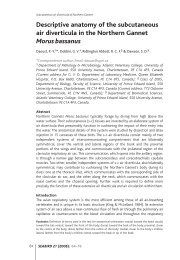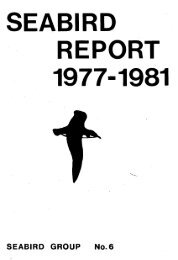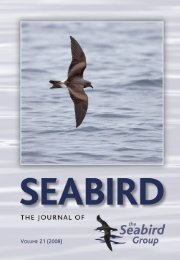Create successful ePaper yourself
Turn your PDF publications into a flip-book with our unique Google optimized e-Paper software.
2001 Body mass reduction in Kittiwakes 173<br />
Gabrielsen et al. (1988) measured the oxygen consumption of 16 adult<br />
Black-legged Kittiwakes, of both sexes, on Svalbard in June/July and found a<br />
resting metabolic rate (RMR) of 1.64 ml O2 g -1 h -1 (= 9.16 W kg -1 , mean body<br />
mass 365 g). Even though the precise reproductive stage for these individuals<br />
was not reported, we assume, based on the dates, that the measurements were<br />
made during the incubation period. In four Black-legged Kittiwakes in Scotland,<br />
mean BMR was found to be 1.62 ml O2 g -1 h -1 (= 9.05 W kg -1 , mean body mass<br />
305 g, Bryant & Furness 1995). Neither the sex nor the reproductive stage of<br />
these individuals was stated. Our own values of BMR from the incubation<br />
period (9.75 and 9.23 W kg -1 ) lie within the range of these previous<br />
measurements of BMR in Black-legged Kittiwakes, but our values from the<br />
chick-rearing period (8.08, 7.16 and 7.38 W kg -1 ) are lower.<br />
<strong>The</strong> mass specific BMR of female Black-legged Kittiwakes decreases<br />
in line with body mass during the chick-rearing period. This implies that the<br />
whole body BMR is reduced by more than would have been expected from an<br />
effect of a decrease in body mass alone. Accordingly, BMR changes in<br />
proportion to BM 2.18 (see eq. 1). This mass exponent exceeds the exponent<br />
expected for a homomorphic variation in BMR (0.67), and it indicates that<br />
lightweight individuals have a relative, as well as an absolute, lower BMR than<br />
heavier individuals, and that a small change in body mass will have a profound<br />
effect on the BMR. This is further demonstrated by the relationship between the<br />
residuals of BMR and the days after hatching (Fig. 2), which shows that during<br />
incubation females even have relatively higher BMR than would be expected by<br />
their high body masses.<br />
High mass-exponents have also been found in other birds in situations<br />
that may resemble those experienced during the chick-rearing period. In female<br />
Kestrels Falco tinnunculus, with varying nutritional conditions, the exponent<br />
was 1.6 (Daan et al. 1989). In a study of Zebra Finches Taeniopygia guttata,<br />
with experimentally increased workloads, the intra-individual mass exponent of<br />
the metabolic rate was 2.30 (Deerenberg et al. 1998). Obviously, in these<br />
studies, including our own, the change in metabolic intensity must have<br />
involved mechanis ms other than an overall body mass change.<br />
A growing understanding exists as to how an inter- and intra-specific<br />
variation in BMR reflects variations in body composition (Daan et al. 1990;<br />
Weber & Piers ma 1996). Different organs and tissues vary in their intrinsic<br />
metabolic rates (Krebs 1950). Organs such as the liver, heart, kidney and<br />
intestine have high metabolic rates, whereas fat and muscle tissues have low<br />
metabolic rates. In this way, BMR level may reflect the relative sizes of<br />
different organs (Daan et al. 1990). Within an individual, a rearrangement of<br />
body composition may be an adaptation or a response to different situations<br />
according to a use/disuse principle (Piers ma & Lindström 1997) and this may in








